Renaissance Art: Anatomy, Dissection, and Artistic Evolution
VerifiedAdded on 2022/08/01
|6
|1151
|38
Essay
AI Summary
This essay provides an overview of Renaissance art, highlighting the significant impact of human anatomy and dissection on artistic development. It explores how artists, driven by a desire for realism and scientific accuracy, began to dissect human bodies, defying restrictions imposed by the Catholic Church. The essay discusses key figures such as Antonio Pallaiuolo, Giotto, Michelangelo, and Leonardo da Vinci, detailing their contributions to anatomical understanding and its integration into their artwork. It examines the use of linear perspective, geometry, and scientific naturalism to create more realistic representations of the human body. The essay also touches upon the development of anatomical illustrations, such as Fasciculus medicinae, and the influence of three-dimensional plans in anatomical studies. It concludes by emphasizing the crucial role of anatomical knowledge in shaping the artistic style and evolution of the Renaissance period, demonstrating a clear shift from medieval art towards a more scientifically informed approach.
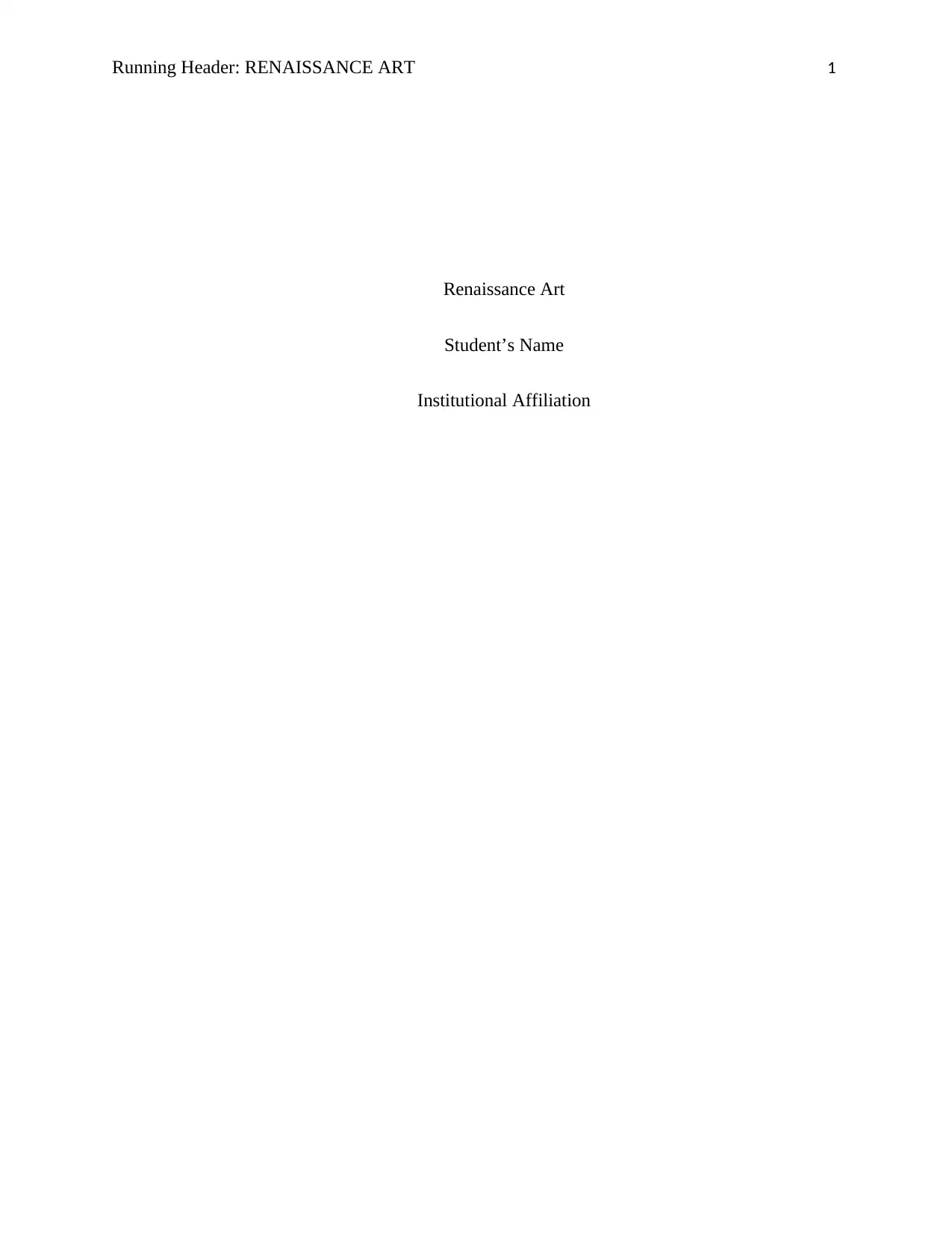
Running Header: RENAISSANCE ART 1
Renaissance Art
Student’s Name
Institutional Affiliation
Renaissance Art
Student’s Name
Institutional Affiliation
Paraphrase This Document
Need a fresh take? Get an instant paraphrase of this document with our AI Paraphraser
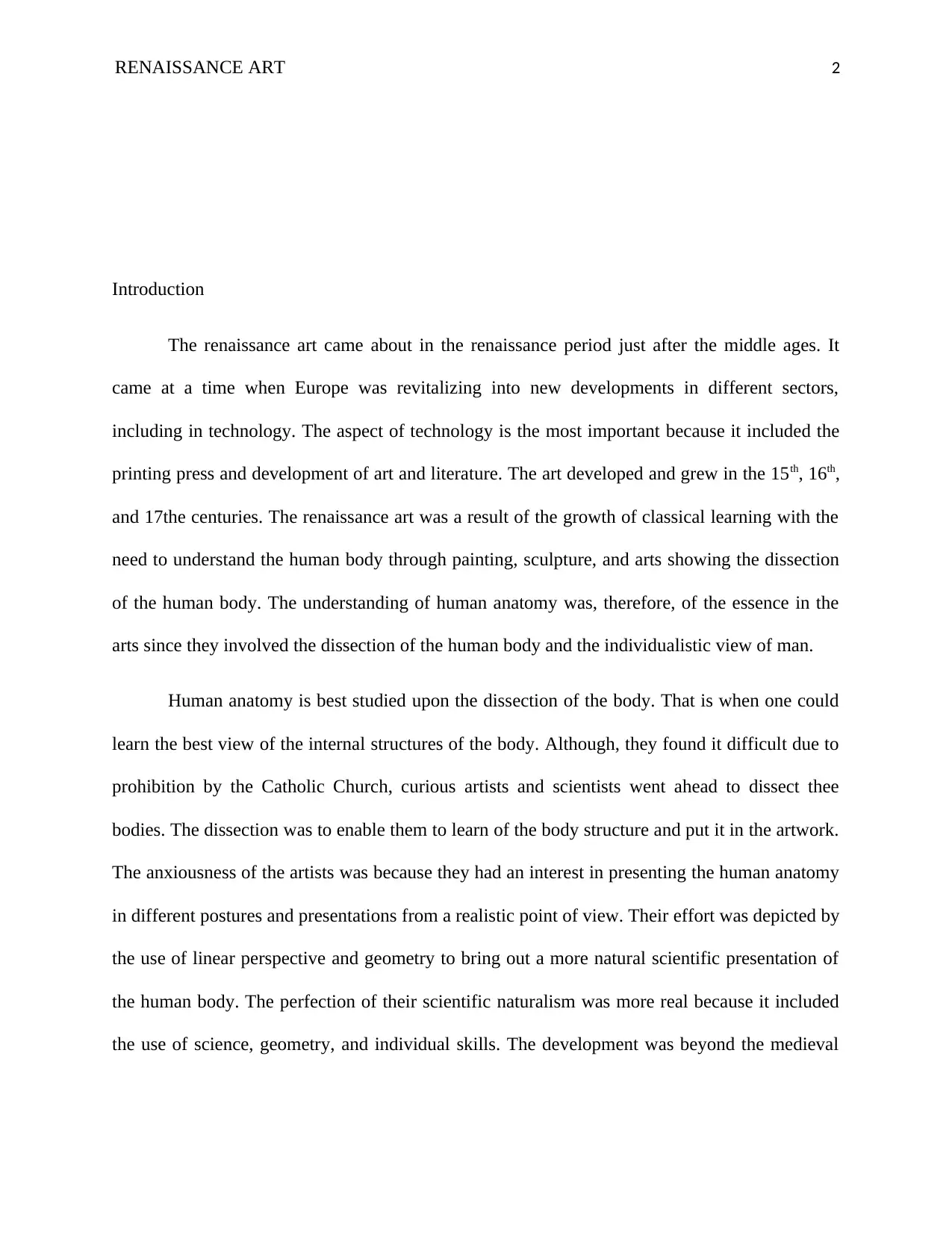
RENAISSANCE ART 2
Introduction
The renaissance art came about in the renaissance period just after the middle ages. It
came at a time when Europe was revitalizing into new developments in different sectors,
including in technology. The aspect of technology is the most important because it included the
printing press and development of art and literature. The art developed and grew in the 15th, 16th,
and 17the centuries. The renaissance art was a result of the growth of classical learning with the
need to understand the human body through painting, sculpture, and arts showing the dissection
of the human body. The understanding of human anatomy was, therefore, of the essence in the
arts since they involved the dissection of the human body and the individualistic view of man.
Human anatomy is best studied upon the dissection of the body. That is when one could
learn the best view of the internal structures of the body. Although, they found it difficult due to
prohibition by the Catholic Church, curious artists and scientists went ahead to dissect thee
bodies. The dissection was to enable them to learn of the body structure and put it in the artwork.
The anxiousness of the artists was because they had an interest in presenting the human anatomy
in different postures and presentations from a realistic point of view. Their effort was depicted by
the use of linear perspective and geometry to bring out a more natural scientific presentation of
the human body. The perfection of their scientific naturalism was more real because it included
the use of science, geometry, and individual skills. The development was beyond the medieval
Introduction
The renaissance art came about in the renaissance period just after the middle ages. It
came at a time when Europe was revitalizing into new developments in different sectors,
including in technology. The aspect of technology is the most important because it included the
printing press and development of art and literature. The art developed and grew in the 15th, 16th,
and 17the centuries. The renaissance art was a result of the growth of classical learning with the
need to understand the human body through painting, sculpture, and arts showing the dissection
of the human body. The understanding of human anatomy was, therefore, of the essence in the
arts since they involved the dissection of the human body and the individualistic view of man.
Human anatomy is best studied upon the dissection of the body. That is when one could
learn the best view of the internal structures of the body. Although, they found it difficult due to
prohibition by the Catholic Church, curious artists and scientists went ahead to dissect thee
bodies. The dissection was to enable them to learn of the body structure and put it in the artwork.
The anxiousness of the artists was because they had an interest in presenting the human anatomy
in different postures and presentations from a realistic point of view. Their effort was depicted by
the use of linear perspective and geometry to bring out a more natural scientific presentation of
the human body. The perfection of their scientific naturalism was more real because it included
the use of science, geometry, and individual skills. The development was beyond the medieval
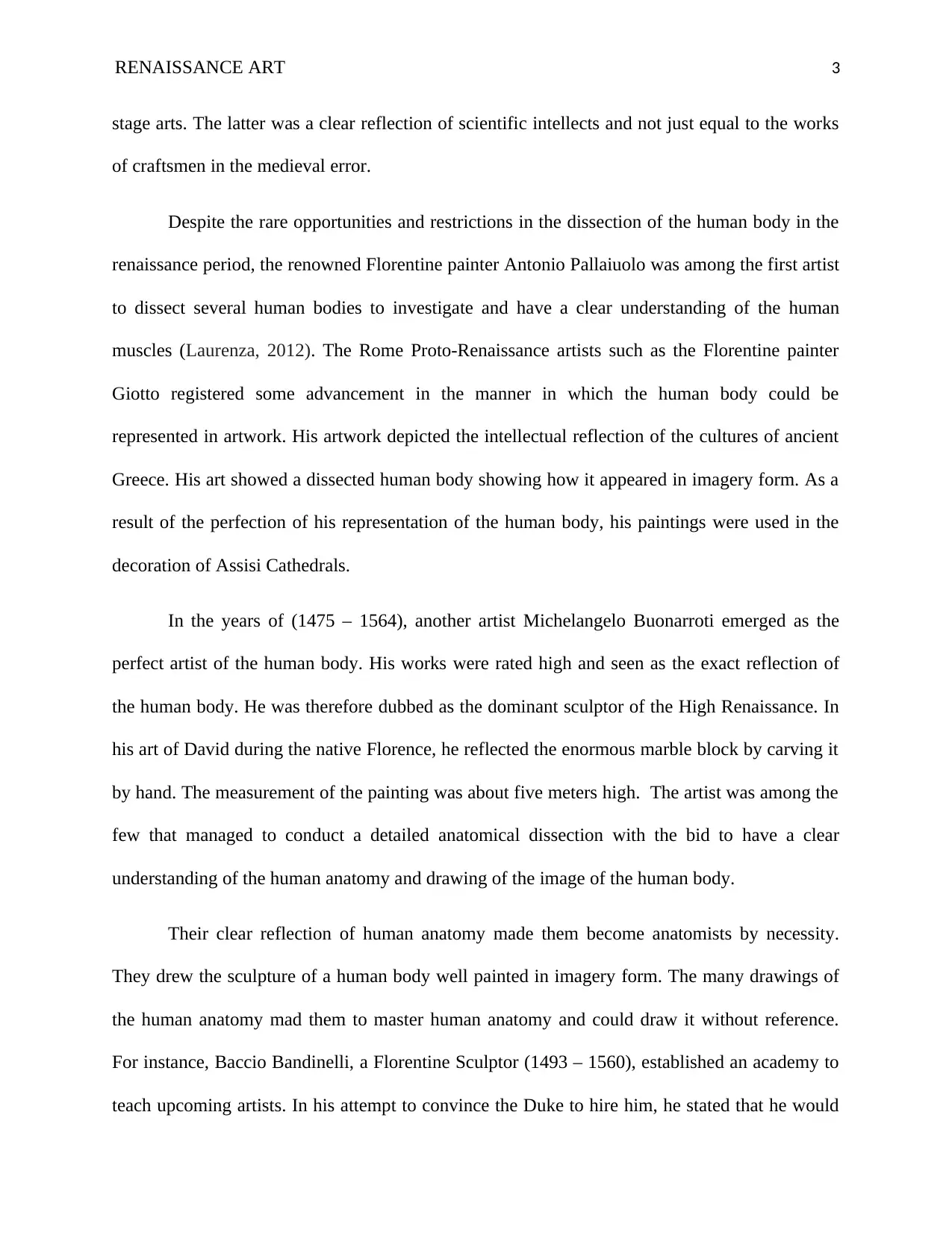
RENAISSANCE ART 3
stage arts. The latter was a clear reflection of scientific intellects and not just equal to the works
of craftsmen in the medieval error.
Despite the rare opportunities and restrictions in the dissection of the human body in the
renaissance period, the renowned Florentine painter Antonio Pallaiuolo was among the first artist
to dissect several human bodies to investigate and have a clear understanding of the human
muscles (Laurenza, 2012). The Rome Proto-Renaissance artists such as the Florentine painter
Giotto registered some advancement in the manner in which the human body could be
represented in artwork. His artwork depicted the intellectual reflection of the cultures of ancient
Greece. His art showed a dissected human body showing how it appeared in imagery form. As a
result of the perfection of his representation of the human body, his paintings were used in the
decoration of Assisi Cathedrals.
In the years of (1475 – 1564), another artist Michelangelo Buonarroti emerged as the
perfect artist of the human body. His works were rated high and seen as the exact reflection of
the human body. He was therefore dubbed as the dominant sculptor of the High Renaissance. In
his art of David during the native Florence, he reflected the enormous marble block by carving it
by hand. The measurement of the painting was about five meters high. The artist was among the
few that managed to conduct a detailed anatomical dissection with the bid to have a clear
understanding of the human anatomy and drawing of the image of the human body.
Their clear reflection of human anatomy made them become anatomists by necessity.
They drew the sculpture of a human body well painted in imagery form. The many drawings of
the human anatomy mad them to master human anatomy and could draw it without reference.
For instance, Baccio Bandinelli, a Florentine Sculptor (1493 – 1560), established an academy to
teach upcoming artists. In his attempt to convince the Duke to hire him, he stated that he would
stage arts. The latter was a clear reflection of scientific intellects and not just equal to the works
of craftsmen in the medieval error.
Despite the rare opportunities and restrictions in the dissection of the human body in the
renaissance period, the renowned Florentine painter Antonio Pallaiuolo was among the first artist
to dissect several human bodies to investigate and have a clear understanding of the human
muscles (Laurenza, 2012). The Rome Proto-Renaissance artists such as the Florentine painter
Giotto registered some advancement in the manner in which the human body could be
represented in artwork. His artwork depicted the intellectual reflection of the cultures of ancient
Greece. His art showed a dissected human body showing how it appeared in imagery form. As a
result of the perfection of his representation of the human body, his paintings were used in the
decoration of Assisi Cathedrals.
In the years of (1475 – 1564), another artist Michelangelo Buonarroti emerged as the
perfect artist of the human body. His works were rated high and seen as the exact reflection of
the human body. He was therefore dubbed as the dominant sculptor of the High Renaissance. In
his art of David during the native Florence, he reflected the enormous marble block by carving it
by hand. The measurement of the painting was about five meters high. The artist was among the
few that managed to conduct a detailed anatomical dissection with the bid to have a clear
understanding of the human anatomy and drawing of the image of the human body.
Their clear reflection of human anatomy made them become anatomists by necessity.
They drew the sculpture of a human body well painted in imagery form. The many drawings of
the human anatomy mad them to master human anatomy and could draw it without reference.
For instance, Baccio Bandinelli, a Florentine Sculptor (1493 – 1560), established an academy to
teach upcoming artists. In his attempt to convince the Duke to hire him, he stated that he would
⊘ This is a preview!⊘
Do you want full access?
Subscribe today to unlock all pages.

Trusted by 1+ million students worldwide
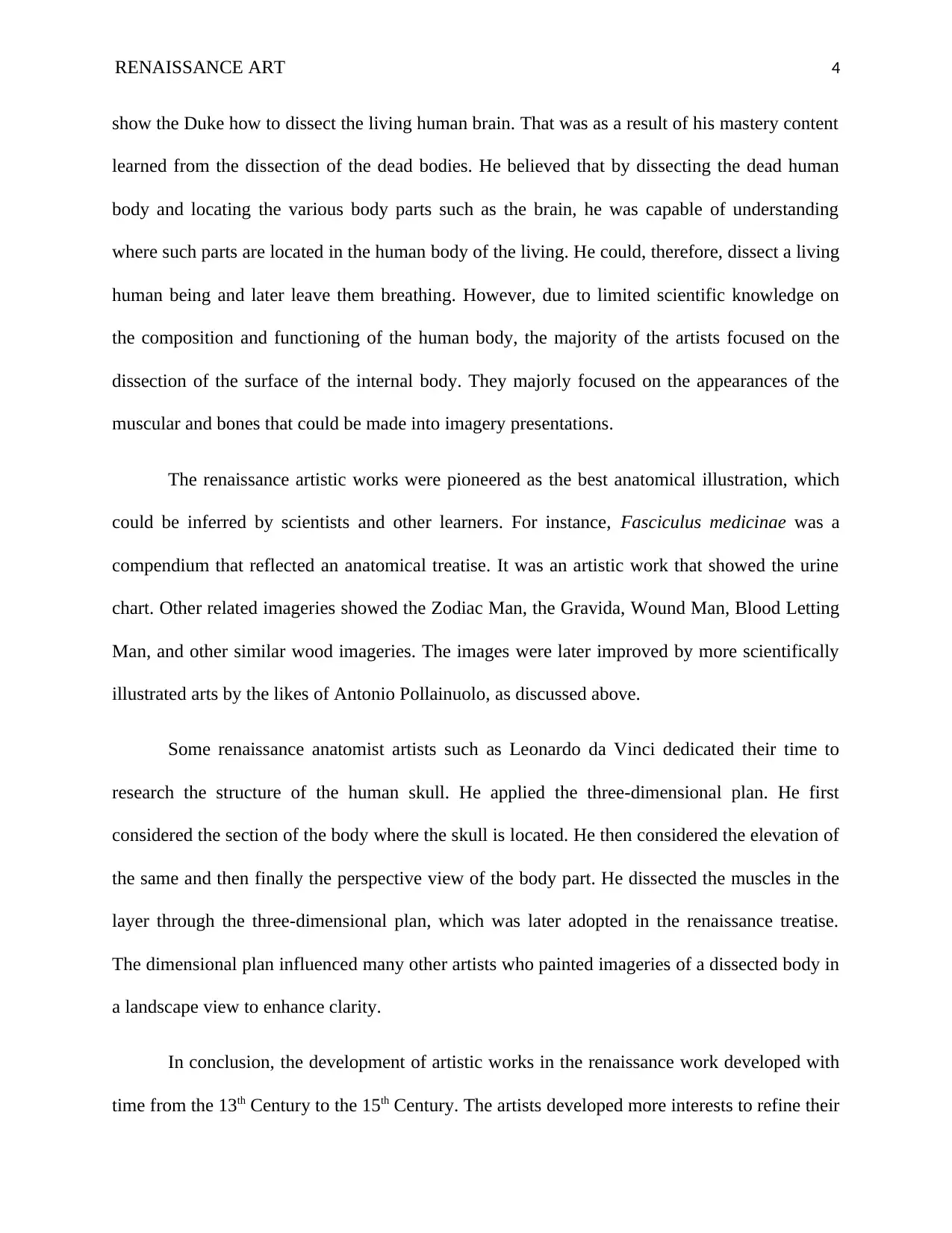
RENAISSANCE ART 4
show the Duke how to dissect the living human brain. That was as a result of his mastery content
learned from the dissection of the dead bodies. He believed that by dissecting the dead human
body and locating the various body parts such as the brain, he was capable of understanding
where such parts are located in the human body of the living. He could, therefore, dissect a living
human being and later leave them breathing. However, due to limited scientific knowledge on
the composition and functioning of the human body, the majority of the artists focused on the
dissection of the surface of the internal body. They majorly focused on the appearances of the
muscular and bones that could be made into imagery presentations.
The renaissance artistic works were pioneered as the best anatomical illustration, which
could be inferred by scientists and other learners. For instance, Fasciculus medicinae was a
compendium that reflected an anatomical treatise. It was an artistic work that showed the urine
chart. Other related imageries showed the Zodiac Man, the Gravida, Wound Man, Blood Letting
Man, and other similar wood imageries. The images were later improved by more scientifically
illustrated arts by the likes of Antonio Pollainuolo, as discussed above.
Some renaissance anatomist artists such as Leonardo da Vinci dedicated their time to
research the structure of the human skull. He applied the three-dimensional plan. He first
considered the section of the body where the skull is located. He then considered the elevation of
the same and then finally the perspective view of the body part. He dissected the muscles in the
layer through the three-dimensional plan, which was later adopted in the renaissance treatise.
The dimensional plan influenced many other artists who painted imageries of a dissected body in
a landscape view to enhance clarity.
In conclusion, the development of artistic works in the renaissance work developed with
time from the 13th Century to the 15th Century. The artists developed more interests to refine their
show the Duke how to dissect the living human brain. That was as a result of his mastery content
learned from the dissection of the dead bodies. He believed that by dissecting the dead human
body and locating the various body parts such as the brain, he was capable of understanding
where such parts are located in the human body of the living. He could, therefore, dissect a living
human being and later leave them breathing. However, due to limited scientific knowledge on
the composition and functioning of the human body, the majority of the artists focused on the
dissection of the surface of the internal body. They majorly focused on the appearances of the
muscular and bones that could be made into imagery presentations.
The renaissance artistic works were pioneered as the best anatomical illustration, which
could be inferred by scientists and other learners. For instance, Fasciculus medicinae was a
compendium that reflected an anatomical treatise. It was an artistic work that showed the urine
chart. Other related imageries showed the Zodiac Man, the Gravida, Wound Man, Blood Letting
Man, and other similar wood imageries. The images were later improved by more scientifically
illustrated arts by the likes of Antonio Pollainuolo, as discussed above.
Some renaissance anatomist artists such as Leonardo da Vinci dedicated their time to
research the structure of the human skull. He applied the three-dimensional plan. He first
considered the section of the body where the skull is located. He then considered the elevation of
the same and then finally the perspective view of the body part. He dissected the muscles in the
layer through the three-dimensional plan, which was later adopted in the renaissance treatise.
The dimensional plan influenced many other artists who painted imageries of a dissected body in
a landscape view to enhance clarity.
In conclusion, the development of artistic works in the renaissance work developed with
time from the 13th Century to the 15th Century. The artists developed more interests to refine their
Paraphrase This Document
Need a fresh take? Get an instant paraphrase of this document with our AI Paraphraser
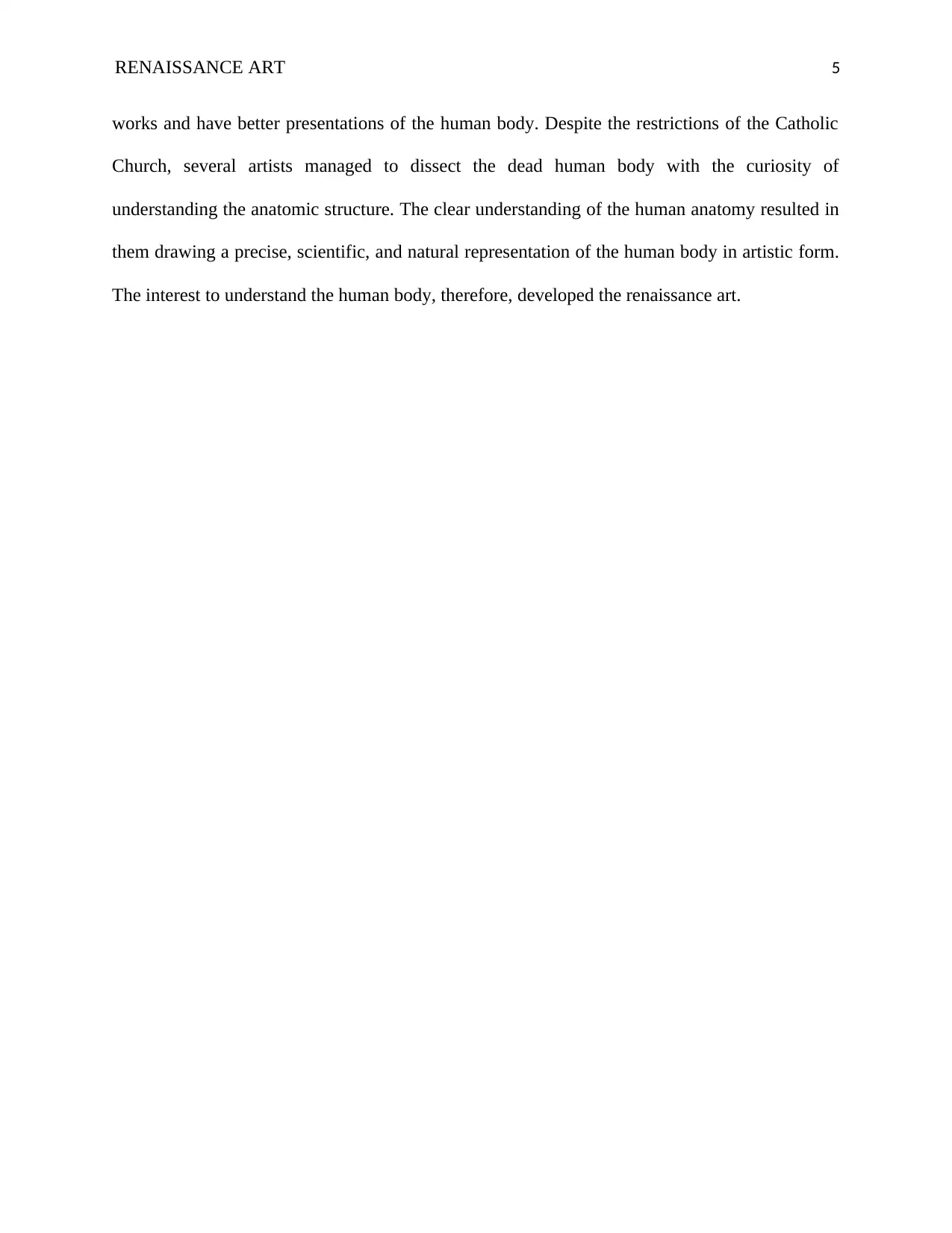
RENAISSANCE ART 5
works and have better presentations of the human body. Despite the restrictions of the Catholic
Church, several artists managed to dissect the dead human body with the curiosity of
understanding the anatomic structure. The clear understanding of the human anatomy resulted in
them drawing a precise, scientific, and natural representation of the human body in artistic form.
The interest to understand the human body, therefore, developed the renaissance art.
works and have better presentations of the human body. Despite the restrictions of the Catholic
Church, several artists managed to dissect the dead human body with the curiosity of
understanding the anatomic structure. The clear understanding of the human anatomy resulted in
them drawing a precise, scientific, and natural representation of the human body in artistic form.
The interest to understand the human body, therefore, developed the renaissance art.
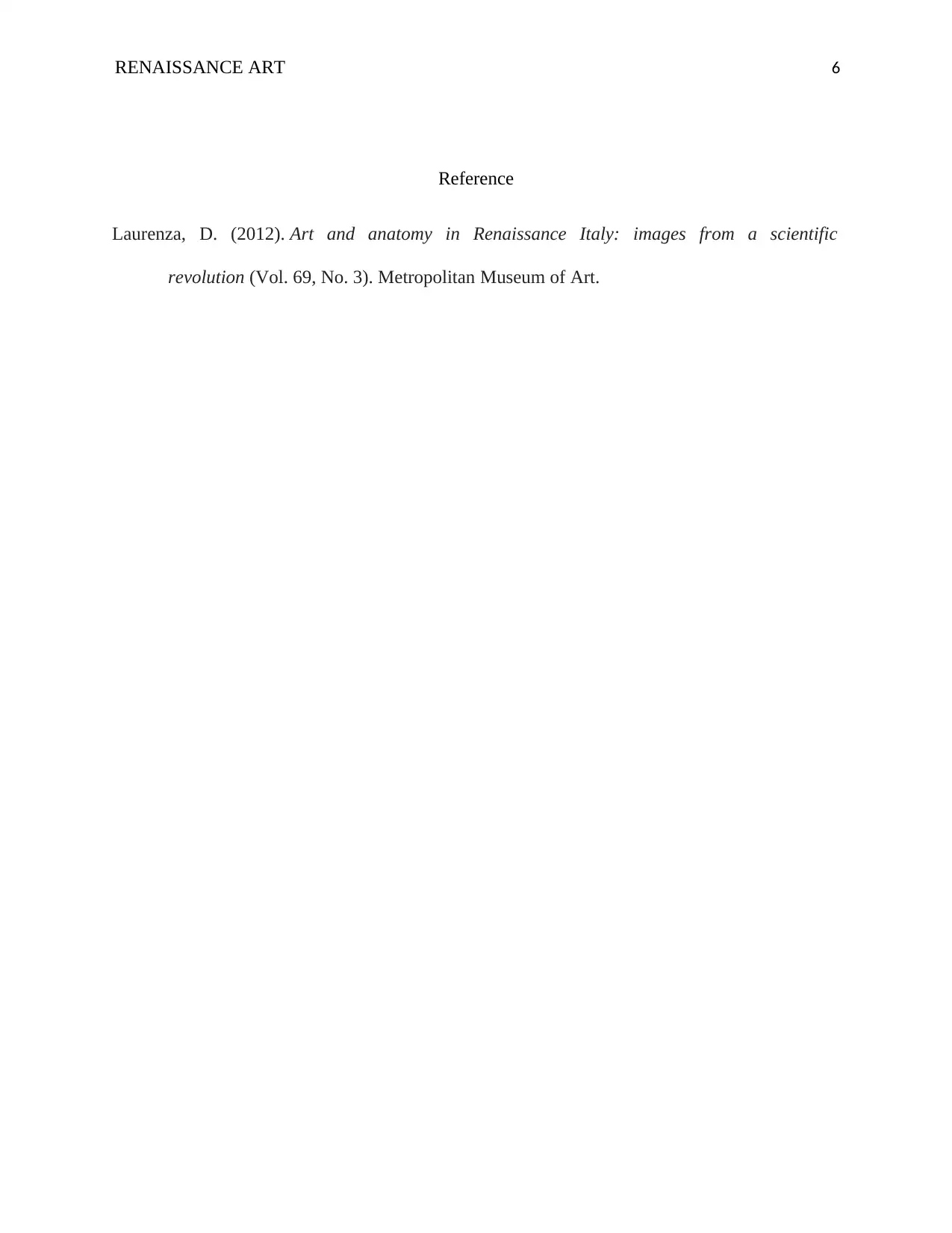
RENAISSANCE ART 6
Reference
Laurenza, D. (2012). Art and anatomy in Renaissance Italy: images from a scientific
revolution (Vol. 69, No. 3). Metropolitan Museum of Art.
Reference
Laurenza, D. (2012). Art and anatomy in Renaissance Italy: images from a scientific
revolution (Vol. 69, No. 3). Metropolitan Museum of Art.
⊘ This is a preview!⊘
Do you want full access?
Subscribe today to unlock all pages.

Trusted by 1+ million students worldwide
1 out of 6
Related Documents
Your All-in-One AI-Powered Toolkit for Academic Success.
+13062052269
info@desklib.com
Available 24*7 on WhatsApp / Email
![[object Object]](/_next/static/media/star-bottom.7253800d.svg)
Unlock your academic potential
Copyright © 2020–2025 A2Z Services. All Rights Reserved. Developed and managed by ZUCOL.




